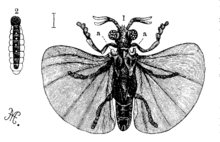Xenos vesparum
Xenos vesparum is an insect species, whose females are permanent entomophagous endoparasites of Polistes paper wasps. They dwell their entire lifespan in the abdomen of the wasp. Two particular species of social wasp it has been known to infect are Polistes gallicus and Polistes dominula.[1] Younger members of a wasp colony tend to be targeted, although X. vesparum displays parasitic behavior in all stages of this host.[2]
| Xenos vesparum | |
|---|---|
 | |
| Male Xenos peckii in its winged insect stage (1), and female Xenos rossii in its neotenic stage (2). | |
| Scientific classification | |
| Kingdom: | |
| Phylum: | |
| Class: | |
| Order: | |
| Family: | Xenidae |
| Subfamily: | Xeninae |
| Genus: | Xenos |
| Species: | Xenos vesparum Rossi, 1793 |
According to Fabio Manfredini of Pennsylvania State University, co-author of an animal behaviour study of this insect's odd life cycle, published on 8 October 2011, the parasite infects a European paper wasp and completely alters its worker caste behaviour. The infected wasp begins to suffer nutritionally, then flies to meet with other infected wasps. The male parasite, which pupated in the infected wasp, exits the wasp's abdomen as a winged insect and mates with the female parasites which stay inside their host. Wasps infected with the male parasite die. Wasps infected with the female parasite then fatten themselves up much like queen wasps do. They then fly to meet with other uninfected queen wasps. Then when the parasite is mature, the infected wasp flies to mingle with other uninfected wasps, thereby spreading brood and larvae into new environments.[1][3][4]
References
- Cappa, Federico; Manfredini, Fabio; Dallai, Romano; Gottardo, Marco; Beani, Laura (2014). "Parasitic castration by Xenos vesparum depends on host gender". Parasitology. 141 (8): 1080–1087. doi:10.1017/S003118201400047X. ISSN 0031-1820.
- Hughes, D.P.; J. Kathirithamby; L. Beani (2004). "Prevalence of the parasite Strepsiptera in adult Polistes wasps: field collections and literature overview". Ethology, Ecology and Evolution. 16 (4): 363–375. doi:10.1080/08927014.2004.9522627.
- Keim, Brandon (2011-10-19). "Parasite Turns Wasps Into Outsider Zombie Queens". Wired. ISSN 1059-1028. Retrieved 2020-05-25.
- Beani, Laura; Dallai, Romano; Mercati, David; Cappa, Federico; Giusti, Fabiola; Manfredini, Fabio (2011-12-01). "When a parasite breaks all the rules of a colony: morphology and fate of wasps infected by a strepsipteran endoparasite". Animal Behaviour. 82 (6): 1305–1312. doi:10.1016/j.anbehav.2011.09.012. ISSN 0003-3472.
Sources
- R. Dallai; L. Beani; J. Kathirithamby; P. Lupetti & B. A. Afzelius (2003), "New findings on sperm ultrastructure of Xenos vesparum (Rossi) (Strepsiptera, Insecta)", Tissue and Cell, 35 (1): 19–27, doi:10.1016/S0040-8166(02)00099-X, PMID 12589726
- Fabiola Giusti; Luigi Dallai; Laura Beani; Fabio Manfredini & Romano Dallai (2007), "The midgut ultrastructure of the endoparasite Xenos vesparum (Rossi) (Insecta, Strepsiptera) during post-embryonic development and stable carbon isotopic analyses of the nutrient uptake", Arthropod Structure & Development, 36 (2): 183–97, doi:10.1016/j.asd.2007.01.001, PMID 18089098